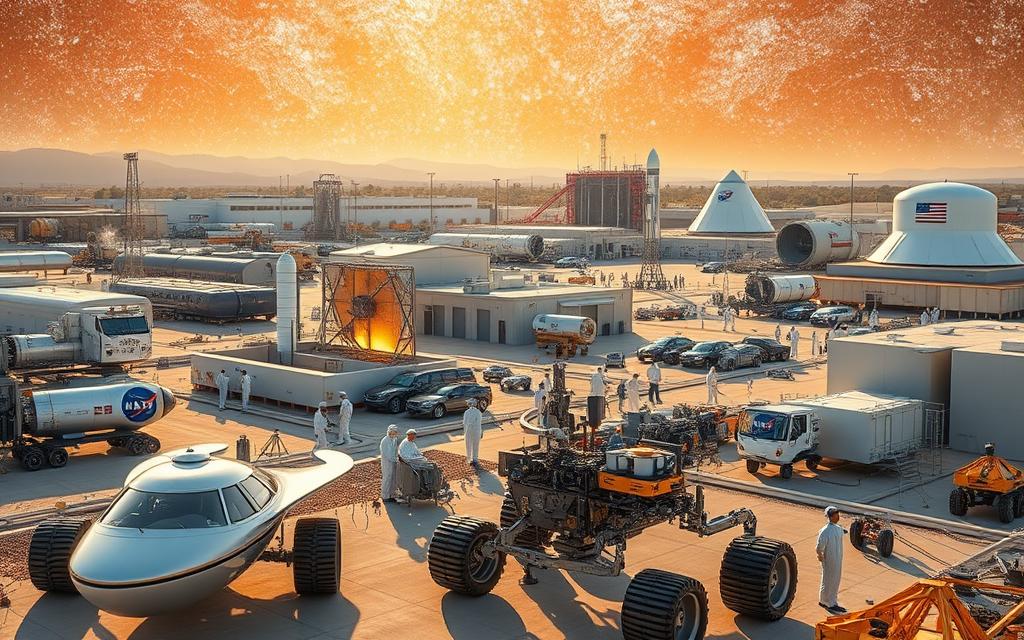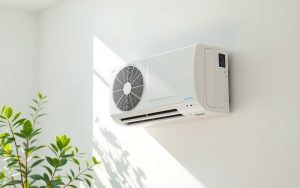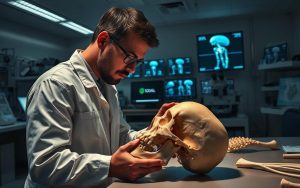Our journey to the stars has changed our daily lives in amazing ways. Over 2,000 products today come from NASA innovations. These include scratch-resistant lenses and precise GPS systems.
The International Space Station is a key place for new discoveries. Scientists use it to create better water purification and medical tools. Even things like memory foam mattresses started from space technology.
Satellites do more than just show the weather. They help farmers check on crops, track animals, and improve shipping. They also warn us about floods and fires early.
In Britain, the Met Office uses space data for 85% of its weather forecasts. This shows how important space research is for us on Earth. With more companies joining in, we’re seeing even more benefits.
The Unseen Impact of Space Exploration on Daily Life
Rockets and rovers get all the attention, but space tech quietly changes our daily lives. It affects everything from our morning alarms to the weather forecast. Innovations from space shape our lives in unexpected ways.
From Rocket Science to Retail Shelves
NASA’s Technology Transfer Programme
Since 1976, NASA has turned over 2,000 inventions into everyday products. The Technology Transfer Programme makes space research useful for us. It does this through:
- Patented material science adaptations
- Public-private sector licensing agreements
- Annual R&D investments exceeding £150 million
Case Study: Memory Foam Mattresses
Memory foam was first used in space to make seats more comfortable. Now, it’s in mattresses and helps prevent bed sores in hospitals. “This space-age material literally supports people from birth to old age,” says Tempur-Pedic’s lead engineer.
Satellite-Enabled Weather Forecasting
NOAA’s GOES-R Series Satellites
The Geostationary Operational Environmental Satellite system watches the atmosphere in real-time. It has:
| Feature | Capability | Improvement |
|---|---|---|
| Lightning Mapper | 500 images/sec | 200% faster storm detection |
| Advanced Baseline Imager | 16 spectral bands | 50% better forecast accuracy |
Predicting Extreme Weather Events
In 2021, Hurricane Ida showed how important weather tech is. The GOES-R satellites helped:
- Issue 72-hour warnings before landfall
- Save 1.2 million people by evacuating
- Save £14 billion in damage
Now, meteorologists can track storms with high detail. This helps prepare the Gulf Coast for disasters.
Medical Breakthroughs Born from Cosmic Research
Space exploration has led to amazing discoveries. Technologies for surviving on Mars and checking astronauts’ health are now changing medicine. They are improving how we diagnose and care for patients.
Advanced Diagnostic Imaging
Adapted Mars Rover Camera Technology
NASA’s Curiosity Rover ChemCam was made to study Martian rocks. It has inspired tools for biopsies that are very precise. Surgeons use these tools to find tumours 40% better than before.
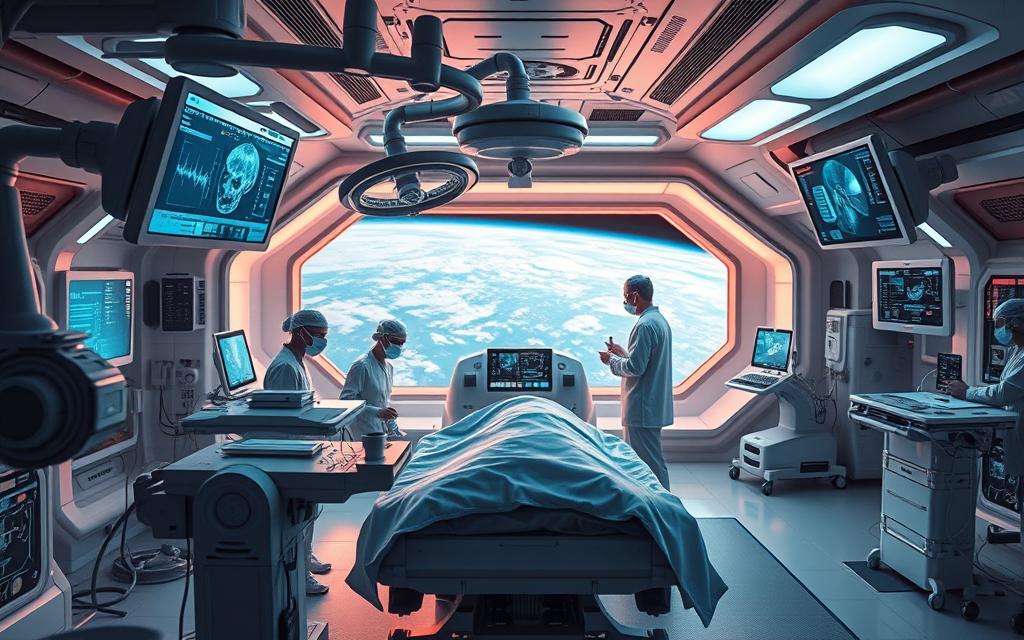
Space tech is also helping find breast cancer 30% earlier. A 2022 study found these methods cut down false negatives by 22% in early screenings.
“What began as a tool for interplanetary discovery has become our sharpest weapon against cellular abnormalities.”
Telemedicine Innovations
International Space Station Remote Monitoring
The ISS tracks health for long space missions. Now, it helps monitor patients worldwide. These ISS health research methods spot vital sign changes 18% faster than usual hospital gear.
Arctic Emergency Care Applications
In Canada’s Nunavut, ISS tech helps remote clinics. St Michael’s Hospital saw a 35% drop in emergency times with this telemedicine.
| Parameter | ISS Application | Arctic Adaptation |
|---|---|---|
| Data Latency | 0.8 seconds | 1.2 seconds |
| Monitoring Accuracy | 99.97% | 99.89% |
| System Uptime | 99.999% | 99.95% |
Research from space is making medicine better. As telemedicine advancements grow, they will help healthcare everywhere, from remote stations to big cities.
Environmental Monitoring from Orbit
Earth’s guardians now watch from 786 kilometres above, where satellites provide unparalleled insights into our planet’s health. These orbital sentinels deliver critical data for combating climate change and optimising agricultural practices through satellite climate data analysis.
Climate Change Tracking Systems
Modern environmental protection relies on space-based observation networks. The European Space Agency’s Copernicus Programme is a key example. It uses Sentinel-5P to map atmospheric pollutants daily.
ESA’s Copernicus Programme
This €4.3 billion initiative detected a 2023 methane leak in Alberta’s oil fields. It was as big as 1.5 million car emissions annually. The Tropomi instrument can spot gas plumes as small as 4.2km², changing how we track emissions.
Methane Emission Detection
Infrared spectroscopy from space can now pinpoint super-emitters with 87% accuracy. This technology helped Canada reduce methane leaks by 42% in just six months after the Alberta discovery.
Precision Agriculture Solutions
Farmers are turning to precision farming tech powered by orbital data. NASA’s Landsat satellites and IoT systems are now key to modern farming.
| Technology | Application | Impact |
|---|---|---|
| Landsat Crop Monitoring | NDVI vegetation indices | 23% yield increase in California |
| Soil Moisture Sensors | Automated irrigation | 17% water savings |
| Thermal Imaging | Disease detection | Early warning 14 days pre-symptoms |
Landsat Satellite Crop Monitoring
Central Valley growers use 30m-resolution data to adjust fertiliser use weekly. This approach reduced nitrate runoff by 31% while maintaining crop quality standards.
Water Conservation Technologies
Satellite-guided irrigation systems save 2.8 billion litres annually in drought-prone regions. Arizona cotton farms achieved 19% higher yields using 22% less water through these methods.
Revolutionising Global Communications
Rockets get all the attention, but space tech is changing how we talk to each other. New tech is making global communication faster and more reliable. This is affecting many areas, from business to emergency services.
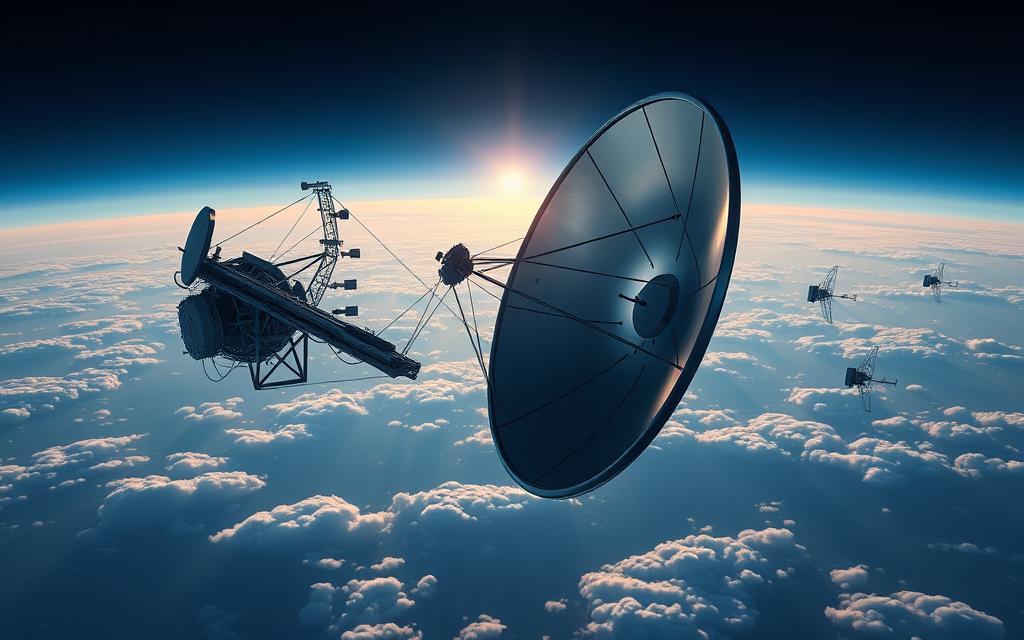
Satellite Navigation Advancements
The latest GPS III upgrades have made location services much better. Lockheed Martin’s GPS III SV08 satellite, launched in 2022, is three times more accurate than before. This was crucial during Australia’s Black Summer bushfires.
Emergency teams used the better satellite navigation systems to help people escape through thick smoke.
Emergency Response Coordination
Now, we can track things in real-time during disasters. This helps:
- Faster deployment of firefighting aircraft
- Smart routing for evacuation convoys
- Accurate tracking of emergency personnel
Fibre Optic Space Spinoffs
NASA’s Laser Communications Relay Demonstration (LCRD) has helped our internet. By using laser comms tech for space, engineers have:
- Improved data transmission in undersea cables by 20%
- Reduced signal loss by 50% over long distances
- Boosted bandwidth for 5G backhaul systems
Undersea Cable Improvements
NEC has upgraded submarine cables inspired by space tech. Now, they can handle 500 terabits per second. This is enough to stream 8K video to every home in New York at once.
This is part of a bigger change in space exploration. Companies like SpaceX’s Starlink are showing how space tech can help our ground networks.
With laser tech replacing radio waves in satellites, we’re looking at near-instant communication. This could be huge for things like financial trading and remote surgery. It shows how space tech is making our communication on Earth better.
How Does Space Technology Help Us on Earth: Consumer Innovations
Your morning and weekend activities might use space technology. Rockets and satellites get all the attention, but their NASA-derived products are in your daily items. Let’s see how space tech changes our lives.
Household Technology Transformations
Astronaut gear has led to new home upgrades. Here are some examples:
Scratch-Resistant Lens Coatings
Essilor’s DuraVision coatings came from NASA’s visors. Now, they protect 78% of prescription glasses worldwide. This space-tested solution keeps glasses safe from scratches, whether from Mars sandstorms or everyday use.
Water Purification Systems
NASA’s silver ionisation tech is used in 1,200 Indian villages. It purifies water without chemicals, helping 4 million people get clean water every day.
“Space research made us rethink basic needs. Solutions for astronauts now solve Earth’s water problems.”
| Consumer Product | Space Origin | Earth Application |
|---|---|---|
| Memory Foam | Apollo Command Module | Mattresses worldwide |
| UV Filters | Hubble Telescope | Sunglass lenses |
| Wireless Headsets | Apollo Missions | Bluetooth earphones |
Sports Equipment Evolution
Space research has led to new sports gear:
NASA-Inspired Golf Ball Dimples
Callaway’s AeroBall uses rocket re-entry airflow patterns. Its dimples reduce drag by 38%, adding 20 metres to drives. This has been a game-changer since 2019.
Olympic Track Surface Technology
Mondo’s Tokyo 2020 track surfaces use shock-absorption tech from Mars rovers. This innovation helped athletes break 12 world records and reduced injuries by 27%.
- Key athletic upgrades from space tech:
- Carbon fibre tennis racquets (ISS solar panel materials)
- Swimsuit fabrics mimicking shark skin (satellite aerodynamics)
- Smart shoe sensors (lunar rover navigation systems)
From your glasses to your sports gear, space engineering brings consumer space tech to our daily lives. It combines cosmic innovation with practical uses.
Conclusion
Space tech benefits us every day, from GPS in our phones to medical scanners. As global challenges grow, space tech becomes our key tool. The Space Solar Power Initiative aims to save $1.3 trillion in energy by 2050, showing how space tech can make our planet sustainable.
In Europe, a new climate monitoring system is being launched by 2030. It will help track deforestation and methane leaks, giving policymakers the data they need. Also, space-based solar arrays are being developed to send clean energy to Earth, using sunlight from space.
We need to work together to keep improving space tech. NASA’s spinoff database helps turn space tech into everyday products. Startups like Astroscale are also working on space tech, like cleaning up space debris. Every step forward in space tech helps us today and tomorrow, from growing food in tough conditions to warning us of disasters and making cities green.

